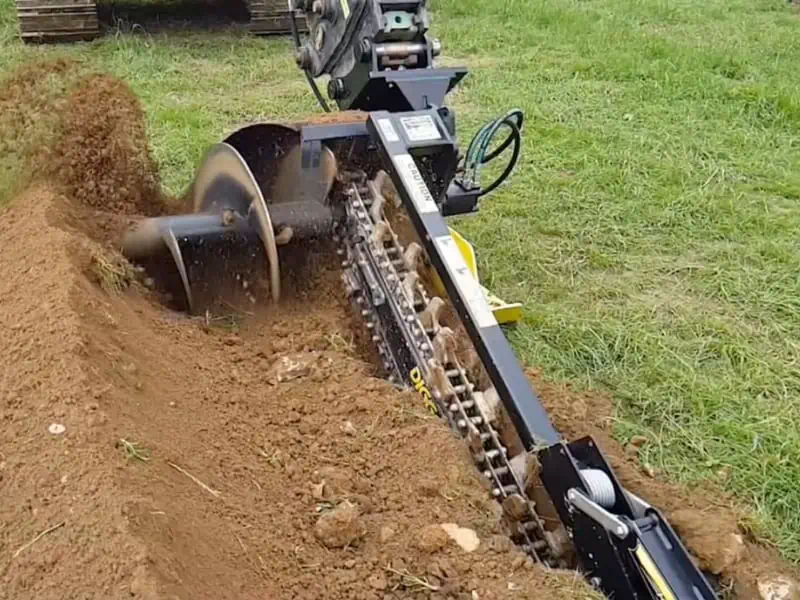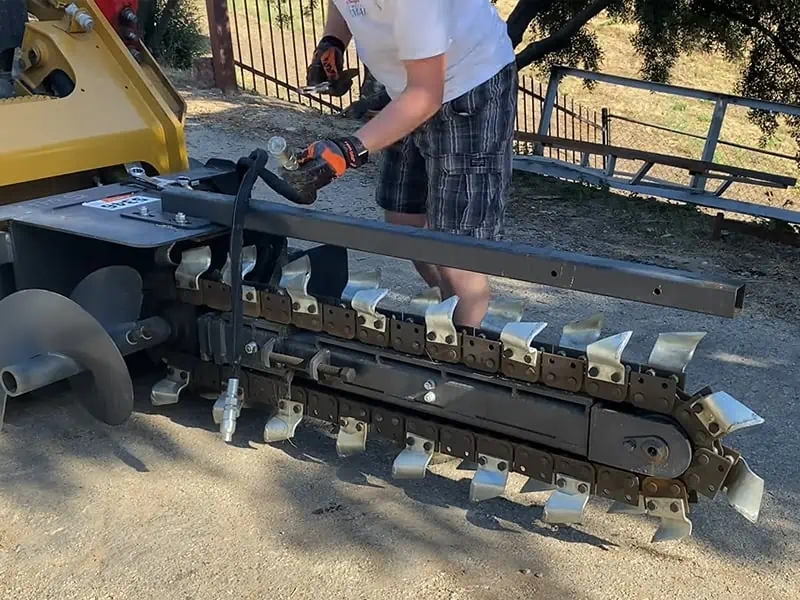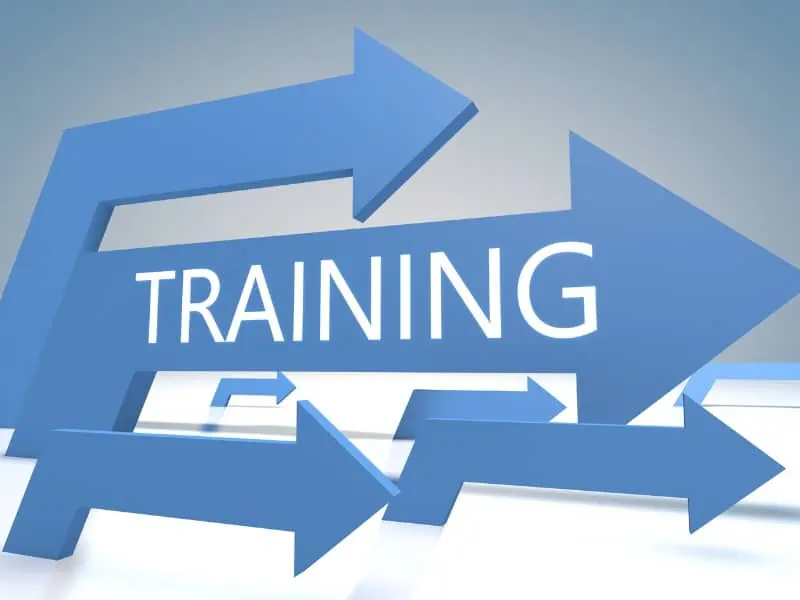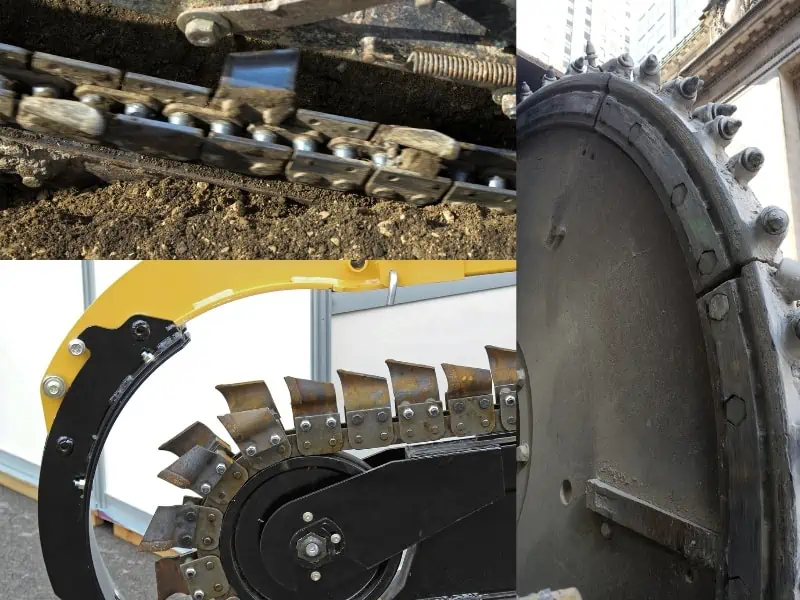Mini excavator trenchers are a piece of equipment that works with the mini excavator. It’s commonly used in construction and landscaping projects to dig narrow trenches to install water, gas, and electrical cables.
The mini excavator trencher comes with a rotating digging chain with cutting teeth that can efficiently cut through soil and other materials. The excavator’s hydraulic system powers the digging chain, and the operator can control the depth and width of the trench with precision.
The compact size of the mini excavator trencher makes it great for working in tight spaces where larger equipment cannot access. Its mobility allows for efficient and quick digging, making it a popular choice for projects with tight deadlines.
Trencher Attachments that can transform your Mini Excavator into a highly productive and versatile trenching machine. This unique combination of equipment can open up countless profitable opportunities for various applications.
Whether you are working on a construction site, landscaping project, or any other trenching project, Mini Excavator Trencher Attachments are the ideal solution for efficient and precise digging.
Table of Contents
ToggleFeatures of Mini Excavator Trenchers
Trenchers are heavy-duty machines designed to excavate trenches in the ground for different applications, such as laying pipes, cables, and drainage systems.

Digging Chain:
The digging chain is the most crucial component of a trencher. It comprises teeth and links that rotate around a sprocket, excavating the soil as it moves. The quality of the digging chain determines the performance of the trencher. Some chains have interchangeable teeth for more versatility.
Auger:
An auger removes soil from the trench and onto a spoil pile. It is founded at the end of the digging chain and can have a different diameter depending on the trencher model.
Boom:
The boom is the main structural component that supports the digging chain and auger. It is usually adjustable, allowing operators to change the depth and angle of the trench. In some models, the boom can also be extended or retracted.
Tires or Tracks:
Trenchers can have either wheels or tracks, depending on the model. Tracks are better suited for rough terrain and provide better traction, while wheels are easier to maneuver and more suitable for flat surfaces.
Двигатель:
The engine powers the hydraulic system that operates the digging chain and other components of the trencher. Depending on the model, it can be powered by gasoline, diesel, or electricity.
Safety Features:
Trenchers come with several safety features to protect operators from injury. These can include automatic shut-off switches, warning lights, and guards to protect the operator from flying debris.
Cutting Depth and Width:
Trenchers can dig trenches of varying depths and widths depending on the model. Some models can dig trenches 6 feet deep and 16 inches wide.
Attachments:
Some trenchers can be fitted with attachments such as backfill blades or vibratory plows, making them more versatile for various jobs.
Controls:
The controls for operating the trencher can vary depending on the model. Some have simple joystick controls, while others have more complex control panels with multiple functions.
Двигатель:
The engine of the mini excavator provides power to the hydraulic system and drives the tracks or wheels. It can be powered by gasoline, diesel, or electricity.
Hydraulic System:
The hydraulic system of the mini excavator provides power to the trencher attachment. It consists of a hydraulic pump, hydraulic lines, and hydraulic cylinders.
How to attach mini excavator Trencher

Attaching a trencher to a mini excavator can vary depending on the specific make and model of the trencher and excavator.
- Check if the trencher is compatible with your mini excavator. Refer to the Trencher manufacturer’s guidelines for compatible mini excavator models.
- Position your mini excavator on a flat surface and ensure it is stable. Use the stabilizers to level the machine and prevent it from tipping over during attachment.
- Align the trencher attachment with the mounting bracket on the excavator’s arm. Use a pin to secure the trencher in place on the mounting bracket.
- Connect the hydraulic hoses of the trencher to the hydraulic couplers on the excavator’s arm. Make sure to follow the color codes and markings on the hoses to ensure they are connected correctly.
- Before using the trencher, test the attachment by moving the arm of the excavator to ensure that it is securely attached and functioning properly.
- Check the hydraulic flow and pressure of the mini excavator to ensure it meets the manufacturer’s recommendations for the trencher attachment.
- Adjust the settings on the trencher attachment, such as depth and speed, to meet the specific requirements of your job.
How to work safely with mini excavator Trencher
Training:
Before operating mini excavator trenchers, it’s important to receive proper training on the machine’s functions and safety features. This training should cover safe operation, maintenance, and emergency procedures.

PPE:
Personal Protective Equipment (PPE) should always be worn when working with a trencher. It includes hard hats, eye and ear protection, steel-toed boots, and high-visibility vests.
Inspect the machine:
Before starting the machine, inspect it to ensure all parts work properly. Check the oil and fluid levels, and look for any signs of damage or wear.
Mark the work area:
Mark the boundaries of the work area with cones or barriers to prevent unauthorized access. It can also help to avoid accidental collisions with other workers or equipment.
Use caution when digging near utilities:
When digging near utilities, use extreme caution to avoid damaging them. Contact local utility companies to locate buried pipes, cables, or other infrastructure before digging.
Keep bystanders away:
Keep bystanders at a safe distance from the work area. Use warning signs and barriers to indicate the boundaries of the work area.
Watch for obstacles:
Watch for obstacles such as rocks, stumps, or debris that could damage the machine or cause it to tip over. If you encounter an obstacle, stop the machine and remove it manually.
Never exceed the machine’s capacity:
Mini excavator trenchers have specific weight and size limitations. Never exceed these limits, as it can cause the machine to become unstable and tip over.
Use the machine’s safety features:
Mini excavator trenchers have several safety features, such as automatic shut-off switches and emergency stops. Always use these features as needed.
Follow the manufacturer’s instructions:
Always follow the manufacturer’s instructions for operating and maintaining the machine. These instructions provide important safety information specific to the machine you are using.
Different types of mini excavator Trencher
Chain Trenchers:Chain trenchers are mini excavator trenchers that use a chain to dig trenches. The chain comprises interconnected digging teeth that rotate around a metal frame. This type of trencher is commonly used for installing pipelines, cables, and drainage systems.

Wheel Trenchers:Wheel trenchers are another type of mini excavator trencher that uses a wheel to dig trenches. The wheel has teeth around the perimeter that cut into the ground as it turns. This type of trencher is ideal for digging trenches in rocky or hard-packed soil.
Micro Trenchers:Micro trenchers are smaller versions of chain trenchers designed for digging narrow trenches. They are commonly used for laying fiber optic cables, electrical lines, and other small utility lines. Micro trenchers are typically used in urban areas where space is limited.
Auger Trenchers:Auger trenchers are a type of mini excavator trencher that uses a rotating helical screw to dig trenches. The screw rotates along the ground, pulling the soil up and out of the trench. This type of trencher is ideal for digging trenches in soft or sandy soil.
Skid Steer Trenchers:Skid steer trenchers are designed to be mounted on a skid steer loader. They are commonly used for digging trenches in construction sites and landscaping projects. Skid steer trenchers are known for their versatility and ease of use.
Vibratory Plow Trenchers:Vibratory plow trenchers use a vibrating blade to cut through the soil and create a trench. The vibrating blade also compacts the soil on either side of the trench, making it ideal for laying utility lines, such as electrical or plumbing. This type of trencher is commonly used in residential areas where the ground is soft or sandy.
The specifications of different mini excavator Trencher
The specifications of different mini excavator trenchers can vary depending on the manufacturer, model, and type of trencher.
Chain Trenchers:
- Digging depth range: 18 inches to 60 inches
- Trench width range: 3 inches to 12 inches
- Hydraulic flow range: 10 GPM to 40 GPM
- Hydraulic pressure range: 1,500 PSI to 3,500 PSI
- Weight range: 500 pounds to 1,000 pounds
- Chain speed range: 400 feet per minute to 900 feet per minute
Wheel Trenchers:
- Digging depth range: 24 inches to 48 inches
- Trench width range: 4 inches to 16 inches
- Hydraulic flow range: 10 GPM to 30 GPM
- Hydraulic pressure range: 2,000 PSI to 3,000 PSI
- Weight range: 1,000 pounds to 1,500 pounds
- Wheel speed range: 300 RPM to 600 RPM
Micro Trenchers:
- Digging depth range: 8 inches to 12 inches
- Trench width range: 0.5 inches to 2 inches
- Hydraulic flow range: 5 GPM to 10 GPM
- Hydraulic pressure range: 1,500 PSI to 2,000 PSI
- Weight range: 300 pounds to 500 pounds
- Chain speed range: 300 feet per minute to 500 feet per minute
Auger Trenchers:
- Digging depth range: 24 inches to 48 inches
- Trench width range: 6 inches to 12 inches
- Hydraulic flow range: 10 GPM to 20 GPM
- Hydraulic pressure range: 2,000 PSI to 3,000 PSI
- Weight range: 1,000 pounds to 1,500 pounds
- Auger speed range: 60 RPM to 100 RPM
Skid Steer Trenchers:
- Digging depth range: 18 inches to 48 inches
- Trench width range: 4 inches to 12 inches
- Hydraulic flow range: 10 GPM to 30 GPM
- Hydraulic pressure range: 2,000 PSI to 3,500 PSI
- Weight range: 500 pounds to 1,000 pounds
- Chain speed range: 400 feet per minute to 800 feet per minute
Vibratory Plow Trenchers:
- Digging depth range: 12 inches to 24 inches
- Trench width range: 2 inches to 4 inches
- Hydraulic flow range: 5 GPM to 15 GPM
- Hydraulic pressure range: 1,500 PSI to 2,500 PSI
- Weight range: 500 pounds to 1,000 pounds
- Vibratory plow speed range: 1,500 RPM to 2,500 RPM
Conclusion
In conclusion, mini excavator trenchers are versatile and efficient tools for digging trenches and holes in various soil conditions. Choosing the right trencher for your mini excavator involves considering job requirements, compatibility, trencher type, size, weight, durability and reliability, and price. You can contact us for more detail about the mini excavator trencher.
